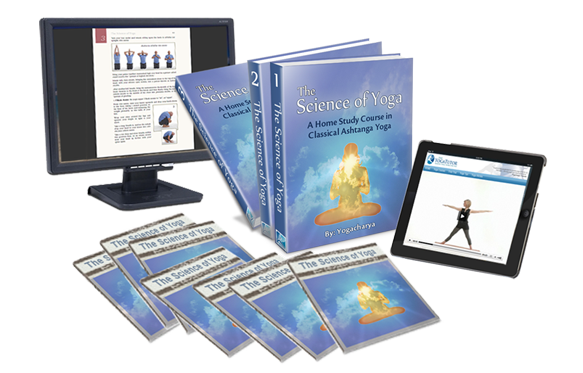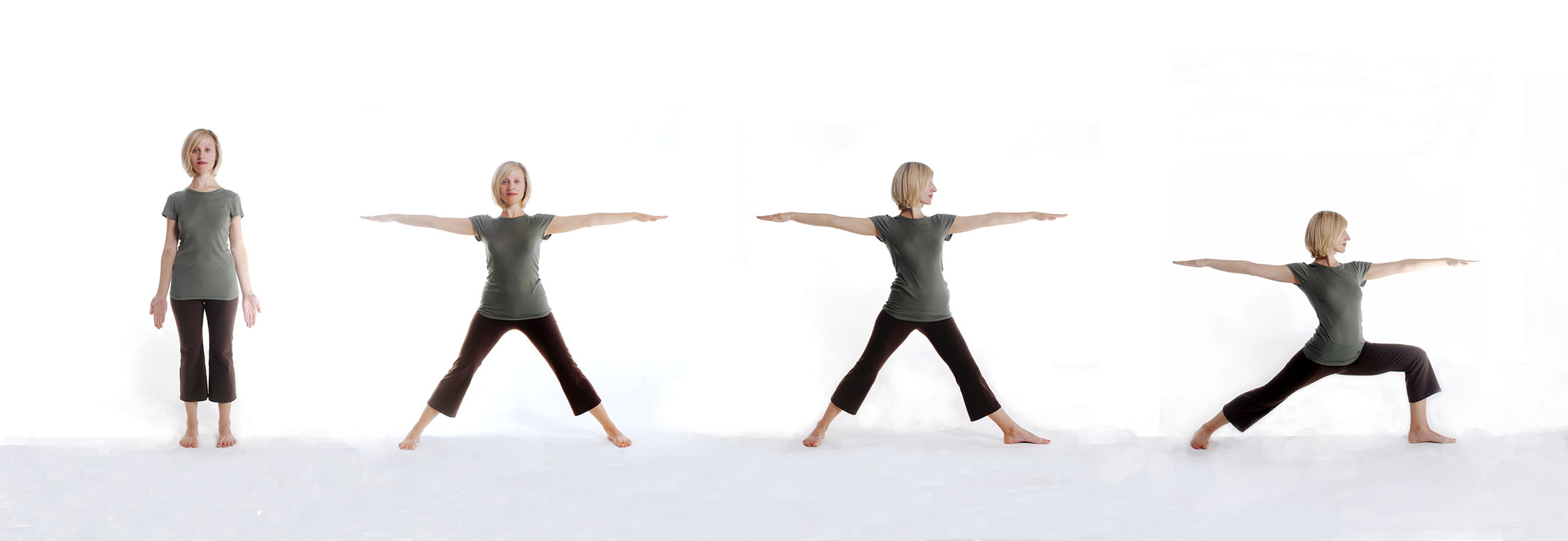[ Excerpt from The Science of Yoga, page 159 ]
The "hero’s pose" has many variations which are performed from a range of standing and sitting positions. I’ll introduce you to two standing poses here. Both are performed from a slightly wider initial open leg stance than that used for the trikona asana.
Virya Asana (I)
Note: These postures are performed first to the right side and then repeated in the same fashion to the left.
- Begin, as in all of the standing postures, from a relaxed sama sthiti asana.
- Jump or step your feet wide apart and raise your arms to the level of the shoulders with the palms facing down.
- Inhale and simultaneously turn your head to the right, looking directly at the right hand, and turn your right foot outward to 90 degrees.
- Maintaining a straight and upright spine, exhale and slowly bend your right knee down to 90 degrees. As in the trikona asana, do not turn your hips or rotate your trunk. Keep your left knee straight and left foot flat and firmly planted on the floor behind you.
- Maintain your gaze overtop of the extended right hand, and hold this posture with firm, warrior resolve—in the beginning from 20-30 seconds, increasing with practice.
- Maintaining a straight and upright spine, inhale and straighten the right knee, coming slowly out of the position.
- Face forward once again and then repeat this sequence to the left side.
- After performing this pose on both sides, finish by jumping or stepping back into sama sthiti asana.
Veerya Asana (II)
- Perform Veerya Asana (I) to the right side, as described in the previous section.
- Rotate your upper torso 90-degrees to face directly toward the bent knee.
- Note: Your arms should remain extended at the level of the shoulders, and now be at right angles to the legs.
- Inhale and raise the arms high over-head, keeping them straight with the palms open forward.
- Again, maintain your gaze straight ahead and hold this posture firmly, while breathing fully, but in a relaxed fashion.
- Come out of the posture in the reverse fashion and repeat on the left side.
- Return to sama sthiti asana and take a few relaxing breaths at the end.
Effects and Benefits
The standing veerya asanas provide great muscular benefit. The muscles of the thighs in particular are enhanced, and the musculatures of the shoulders, back and lower legs are also improved. These practices also help to develop strength within the great weight-bearing joints of the hips, knees and ankles, and in all, infuse the being with a sense of strength and stability.
It takes great mental effort to maintain a 'strong stillness' within these postures and hence, indicative of their name, the successful practice of the veerya asanas imbibe the practitioner with the qualities of a warrior -- strength, stability, vigour, steadiness, courage and unwavering resolve.
[Continued...]
---------------------
NOTE: This yoga article is an excerpt from The Science of Yoga, an online yoga training program with streaming yoga videos and 600 pages of step-by-step yoga instruction.

"The Science of Yoga is a course worthy of
leather binding and an honored place in the
finest libraries in the world
... It is indeed a masterful work."
Dr. John Michael Christian
AwakeningWithYoga.com
Learn More About
The Science of Yoga Course
|








